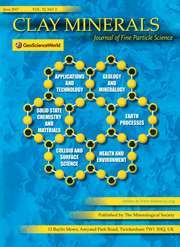Crossref Citations
This article has been cited by the following publications. This list is generated based on data provided by Crossref.
Ball, M. C.
and
Taylor, H. F. W.
1963.
The Dehydration of Chrysotile in Air and under Hydrothermal Conditions.
Mineralogical Magazine and Journal of the Mineralogical Society,
Vol. 33,
Issue. 261,
p.
467.
Shimoda, Susumu
1971.
Mineralogical studies of a species of stevensite from the Obori mine, Yamagata Prefecture, Japan.
Clay Minerals,
Vol. 9,
Issue. 2,
p.
185.
DAW, JEFFREY D.
NICHOLSON, PATRICK S.
and
EMBURY, J. DAVID
1972.
Inhomogeneous Dehydroxylation of Talc.
Journal of the American Ceramic Society,
Vol. 55,
Issue. 3,
p.
149.
Pies, W.
and
Weiss, A.
1974.
References for III/7.
Vol. 7g,
Issue. ,
p.
80.
Aoki, Saburo
Kohyama, Norihiko
and
Sudo, Toshio
1974.
An iron-rich montmorillonite in a sediment core from the northeastern Pacific.
Deep Sea Research and Oceanographic Abstracts,
Vol. 21,
Issue. 10,
p.
865.
Day, Kenrick L.
1976.
Synthetic phyllosilicates and the matrix material of C1 and C2 chondrites.
Icarus,
Vol. 27,
Issue. 4,
p.
561.
Sudo, Toshio
1978.
Clays and Clay Minerals of Japan.
Vol. 26,
Issue. ,
p.
1.
Aoki, Saburo
Kohyama, Norihiko
and
Sudo, Toshio
1979.
Mineralogical and chemical properties of smectites in a sediment core from the southeastern Pacific.
Deep Sea Research Part A. Oceanographic Research Papers,
Vol. 26,
Issue. 8,
p.
893.
Midgley, H.G.
1979.
The use of calcined serpentine as a cement.
Cement and Concrete Research,
Vol. 9,
Issue. 2,
p.
157.
Pieper, G.
Pies, W.
and
Weiss, A.
1985.
Key Element: Si. Part 2.
Vol. 7d1b,
Issue. ,
p.
457.
Pieper, G.
Pies, W.
and
Weiss, A.
1985.
Key Element: Si. Part 2.
Vol. 7d1b,
Issue. ,
p.
474.
Kawano, Motoharu
and
Tomita, Katsutoshi
1991.
X-Ray Powder Diffraction Studies on the Rehydration Properties of Beidellite.
Clays and Clay Minerals,
Vol. 39,
Issue. 1,
p.
77.
Tonui, Eric
Zolensky, Mike
Hiroi, Takahiro
Nakamura, Tomoki
Lipschutz, Michael E.
Wang, Ming-Sheng
and
Okudaira, Kyoko
2014.
Petrographic, chemical and spectroscopic evidence for thermal metamorphism in carbonaceous chondrites I: CI and CM chondrites.
Geochimica et Cosmochimica Acta,
Vol. 126,
Issue. ,
p.
284.
Zolensky, Michael E.
Abreu, Neyda M.
Velbel, Michael A.
Rubin, Alan
Chaumard, Noel
Noguchi, Takaaki
and
Michikami, Tatsuhiro
2018.
Primitive Meteorites and Asteroids.
p.
59.
Pushkarov, Oleksandr
Sevruk, Iryna
Demikhov, Yuriy
Zubko, Oleksandr
Dolin, Vitaliy
and
Shramenko, Ivan
2024.
Influence of mineral adsorbent on efficiency of fractionation of heavy hydrogen isotopes in aqueous solutions.
Visnyk of V.N. Karazin Kharkiv National University, series Geology. Geography. Ecology,
p.
85.


